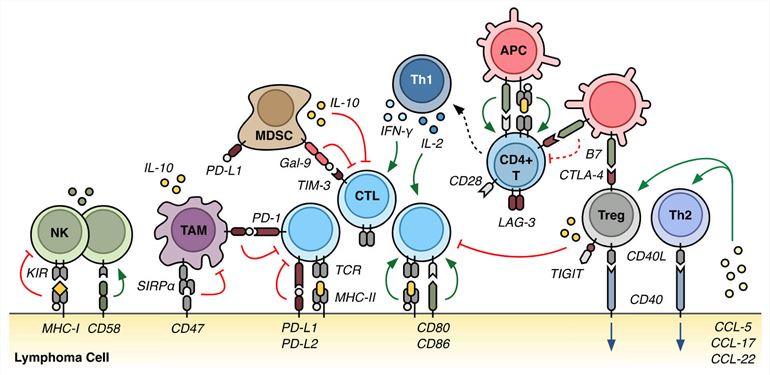Creative Biolabs is one of the leading custom antibody generation and development providers. We specialize in the generation of antibodies against a wide range of targets for R&D, diagnostic, and therapeutic applications. Currently, we have launched a series of in vitro diagnostic (IVD) antibody development services targeting numerous diagnostic biomarkers of human diseases. Here, we focus on lymph cancer and its potential biomarkers.
Basically, there are two ways that cancer appears in the lymph nodes, it can start from there or spread there from somewhere else. Caner that arises from the lymph nodes is called lymphoma. Lymphoma is a group of blood cancers that develop from lymphocytes, a type of white blood cell. The symptoms may include lymph nodes enlargement, fever, drenching sweats, weight loss, itching, and constant tiredness. The enlarged lymph nodes are usually painless. The patients may perspire at night.
 Fig.1 The tumor microenvironment in lymphoma.1
Fig.1 The tumor microenvironment in lymphoma.1
Type
There are several sub-types of lymphomas. Two main categories are called Hodgkin's lymphomas (HL) and the non-Hodgkin lymphomas (NHL). Multiple myeloma and immunoproliferative diseases are two other categories that are included as types of lymphoma by the World Health Organization (WHO).
- Hodgkin's Lymphomas
Hodgkin lymphoma is a rare B-cell malignant neoplasm affecting approximately 9000 new patients every year. This disease represents about 11% of all lymphomas in the United States and comprises 2 discrete disease entities—classical Hodgkin lymphoma and nodular lymphocyte-predominant Hodgkin lymphoma. The classical Hodgkin lymphoma could be further categorized into defined subgroups: nodular sclerosis, mixed cellularity, lymphocyte depletion, and lymphocyte-rich Hodgkin lymphoma.
Staging of this disease is important and essential for the choice of the ideal therapy. The initial treatment for patients with Hodgkin lymphoma is primarily based on the histologic characteristics of the disease. The stage at presentation and the presence or absence of prognostic factors associated with poor outcome are all taken into consideration. Patients with different stages of the disease are treated in different ways. Patients with early-stage Hodgkin lymphoma commonly go through combined-modality therapies that include abbreviated courses of chemotherapy with ensuing involved-field radiation treatment. For the patients who are suffering from advanced-stage Hodgkin lymphoma, they receive a more prolonged course of combination chemotherapy, with radiation therapy used only in selected cases.
- Non-Hodgkin Lymphomas
Non-Hodgkin lymphomas are a heterogeneous group of malignancies of the lymphoid system. According to the World Health Organization classification, these tumors have been classified as B-cell and T-cell neoplasms. B-cell lymphomas account for about 90% of all lymphomas, and the two of the most common histological disease entities are follicular lymphoma and diffuse large B-cell lymphoma. Approximately 58,000 new cases of non-Hodgkin lymphoma are claimed every year in the United States. This number has nearly doubled over the past 3 decades. Recent studies have identified molecular and genetic markers of prognosis that may be used in the future to further refine treatment decisions.
Treatment of these diseases is based on the histologic characterization and extent of disease. Patients suffering from different stages of the disease are treated differently. Patients with follicular lymphomas (early-stage) generally receive radiation therapy, whereas those with stage III and IV disease requiring treatment usually undergo chemotherapy, immunotherapy, or radioimmunotherapy. For patients with diffuse large B-cell lymphoma, they may receive doxorubicin-based chemotherapy combined with anti-CD20 monoclonal antibody followed by involved field radiation therapy. Those patients with extensive disease may be treated with anti-CD20 monoclonal antibody combined with chemotherapy alone.
Diagnosis
Diagnosis is an important step for disease treatment. Appropriate management of lymphoma starts with an accurate and precise diagnosis. Although fine needle aspiration (FNA) can be accurate and cost-effective in terms of diagnosis of certain lymphoma and is accurate in the setting of relapsed disease, excisional biopsy still remains the standard of care for initial diagnosis and for clinical scenarios in which cellular morphology and nodal architecture are associated with the diagnosis. Therefore, to obtain tissue with the greatest diagnostic quality, a diagnosis of lymphoma is ideally based on an excisional lymph node biopsy.
Creative Biolabs offers turn-key or ala carte services customized to suit our client's needs. If you are interested in our platforms or our services, please contact us for more detail information.
Our services target the following potential biomarkers for Lymph cancer diagnosis:
Reference
- Csizmar, Clifford M., and Stephen M. Ansell. "Engaging the innate and adaptive antitumor immune response in lymphoma." International journal of molecular sciences 22.7 (2021): 3302. Distributed under Open Access license CC BY 4.0, without modification.
For Research Use Only.

